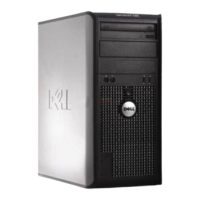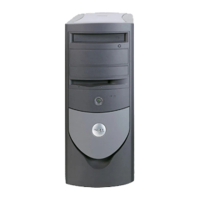Glossary 303
Glossary
Terms in this Glossary are provided for informational purposes only and may or may not describe features included
with your particular computer.
A
AC — alternating current — The form of electricity that
powers your computer when you plug the AC adapter power
cable in to an electrical outlet.
ACPI — advanced configuration and power interface —
A power management specification that enables Microsoft
®
Windows
®
operating systems to put a computer in standby
or hibernate mode to conserve the amount of electrical
power allocated to each device attached to the computer.
AGP — accelerated graphics port — A dedicated graphics
port that allows system memory to be used for video-related
tasks. AGP delivers a smooth, true-color video image
because of the faster interface between the video circuitry
and the computer memory.
ANTIVIRUS SOFTWARE — A program designed to
identify, quarantine, and/or delete viruses from your
computer.
APR — advanced port replicator — A docking device that
allows you to conveniently use a monitor, keyboard, mouse,
and other devices with your portable computer.
ASF — alert standards format — A standard to define a
mechanism for reporting hardware and software alerts to a
management console. ASF is designed to be platform- and
operating system-independent.
B
BACKUP — A copy of a program or data file on a floppy
disk, CD, or hard drive. As a precaution, back up the data
files from your hard drive regularly.
BATTERY — An internal power source used to operate
portable computers when not connected to an AC adapter
and an electrical outlet.
BATTERY LIFE SPAN — The length of time (years)
during which a portable computer battery is able to be
depleted and recharged.
BATTERY OPERATING TIME — The length of time
(minutes or hours) that a portable computer battery holds a
charge while powering the computer.
BIOS — basic input/output system — A program (or
utility) that serves as an interface between the computer
hardware and the operating system. Unless you understand
what effect the settings have on the computer, do not change
the settings for this program. Also referred to as system
setup.
BIT — The smallest unit of data interpreted by your
computer.
B
LUETOOTH™ — A wireless technology standard for
short-range (9 m [29 feet]) networking devices that allows
for enabled devices to automatically recognize each other.
BOOT SEQUENCE — Specifies the order of the devices
from which the computer attempts to boot.
BOOTABLE CD — A CD that you can use to start your
computer. In case your hard drive is damaged or your
computer has a virus, ensure that you always have a
bootable CD or floppy disk available. Your Drivers and
Utilities or Resource CD is a bootable CD.
BOOTABLE DISK — A disk that you can use to start your
computer. In case your hard drive is damaged or your
computer has a virus, ensure that you always have a
bootable CD or floppy disk available.
BPS — bits per second — The standard unit for measuring
data transmission speed.
BTU — British thermal unit — A measurement of heat
output.

